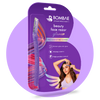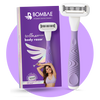That dreaded razor cut!! It gets itchy, it's uncomfortable, makes you self-conscious, and most importantly, it's painful. So, how do you manage to save yourself from them easily and effectively? Keep reading and follow along to get back to your silky smooth skin.
Tips To Avoid Razor Cuts
A good preparation will ensure that you don’t get a cut in the first place. So start with step zero, i.e. exfoliating the skin before you shave. Use a good quality scrub that’s both gentle on the skin and removes all the build-up in your pores, including dead skin cells, excess oil and dirt – revealing a softer skin with open pores which makes removing hair way easier than otherwise.
Keep the following points in mind to avoid getting cut during the process of shaving:
- Always use sharp blades. Dull blades make it difficult to glide the razor smoothly on your skin and may cause not only cuts but also painful tugs and irritation
- Always go with the grain in your first few glides, and then go against the direction of your hair to get closer shaves
- Apply an After Shave Gel after you’re done shaving, as it will help soothe the skin even if you get a slight nick

- If you still manage to get a cut, avoid using hot water after shaving. Hot water irritates the skin and causes further inflammation in the cut
At any point, if you feel your cut is worse than you can handle, go and see a doctor. They will examine the severity of the cut and help speed up the healing process.
What is a Razor Cut?
When you follow an improper method of shaving or do not follow any method at all, razor cuts happen. One of the most common places where this happens is the legs, underarms, and Bikini Line. As a general rule of thumb make sure to end your shaving routine with a skin soothing post-shave balm to reduce the chances of skin irritation or dryness.
How Do You Prevent Razor Cuts?
If you do get Razor cuts, there are a few things that you can do to relieve the discomfort and speed up the healing process.
Apply a Cold Compress
A compress is a tried and tested method to reduce inflammation and soothe that burning sensation. Just use a microfiber towel, and wrap it with some ice, and cold apply it to the affected area for 10-15 minutes at a time, several times a day.
Don’t Shave Until The Cut Gets Healed
Now why would you go in a zone that has been through a lot. Just give it some time to heal, and as a step of caution, avoid shaving in those areas for a while as it can irritate the skin and it may take longer to heal.
Wear Loose-Fitting Clothing
When you have a razor cut on areas like your legs and bikini areas, there is a high chance for your skin to get irritated throughout the day. Avoid this by wearing loose-fitting clothing as it prevents the affected area from rubbing against other clothing and causing further irritation.
Risk Factors For Razor Cuts
When you use a razor with dull blades, or you shave against the grain, you are at a higher risk of getting razor cuts, and these cuts can give you heights of pain and irritating skin itch at the same time.
Skin Type: people with sensitive skin are at a higher risk of getting cuts from a razor.
Hair Type: if you have curly or coarse hair, there are higher chances of hair tugging and pulling, which eventually leads to cuts. Avoid this by using a lubricating Shaving Cream or gel as this makes it easy to shave on lubricated skin.
Shaving Habits: People who shave every day or like almost every day are at a greater risk of getting razor cuts. Avoid this by simply changing the shaving frequency for each week.

Medical Conditions: If you have certain medical conditions like eczema and psoriasis, it increases your risk of razor cuts.
Natural Remedies For Razor Cuts
When it comes to dealing with razor cuts, several natural remedies can help to relieve the pain from razor cuts. Here are a few ways that can be useful for you:
Aloe vera: has anti-inflammatory and skin-soothing properties. It can help you cool down the burning sensation and helps heal the skin faster. Simply apply it to the affected area and rub the gel and let it sit for 8-10 mins.

Oatmeal: You may not be aware of this, but oatmeal has anti-inflammatory and moisturising properties that is a game changer when you're trying to reduce the pain from razor cuts.
Coconut oil: Coconut oil is known for its antibacterial properties that helps soothe the skin and reduce redness, and bumps. Here’s how to use coconut oil to treat razor cuts at home. Simply apply it to the affected area and rub it around the affected area with your palm and let it sit for 13-15 mins and in no time you’ll see a drastic reduction in pain.
Choose The Right Shaving Tools
When it comes to shaving, you just cannot simply choose any random razor in the market. Your skin type and purpose play a big role in this. Here is how it works. If you have sensitive skin, you should go for a razor that’s gentle on your skin, and comes with an additional lubricating strip like the Rollplay from Bombae as it is gentle on the skin. Its advanced roller blades with a lubricating strip and pivot head reduce the chances of nicks and cuts.

If peach fuzz and chin hair is your nemesis you need a Face Razor that safely eliminates them without nicks or cuts. As a general rule of thumb, avoid using shaving products with alcohol or artificial fragrances, as these can irritate the skin.
Next up is your hair type. If you have curly or coarse hair you may want to avoid disposable razors and consider using a good shaving cream or gel with an electric razor as they are less likely to cause razor cuts. Additionally, no matter which razor you go with it is important to replace the blades/cartridges regularly. A dull razor can cause more cuts and irritation.
THAT’S A WRAP
By following the tips above, you can help to prevent and treat razor cuts for good. If you do get them, there are a number of things as shared above you can do to relieve the symptoms and speed up the healing process.












